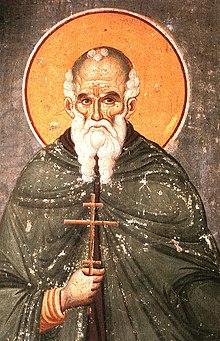Athanasius of Trebizond
| Saint Athanasios of Athos | |
|---|---|

Russian icon of St. Athanasius the Athonite (Sv. Afanasy Afonsky)
|
|
| Born | c. 920 Trebizond, Byzantine Empire |
| Died | c. 1003 Mount Athos |
| Venerated in | Eastern Orthodoxy |
| Major shrine | Great Lavra Monastery, Mount Athos |
| Feast | July 5 |
Athanasius the Athonite (Greek: Αθανάσιος ο Αθωνίτης), also called Athanasios of Trebizond (c. 920 – c. 1003), was a Byzantine monk who founded the monastic community on Mount Athos, which has since evolved into the greatest centre of Eastern Orthodox monasticism.
Born in Trebizond and patronized by Michael Maleinos, he studied at Constantinople and became famous there as Abraham, a fervent preacher who held great authority with Michael's nephew, Nicephorus Phocas. By the time Phocas ascended the imperial throne, Abraham, ill at ease with the lax morals of the monks living in the capital, changed his name to Athanasius and joined the monks at Mount Kyminas in Bithynia. In 958, he relocated to Mount Athos.
He helped defend the hermits, or sketes, there against the Saracens, and also started to incorporate the sketes already there into what would eventually become known as the Great Lavra, which Athanasius built with the financial assistance of Nicephorus. This monastery was dedicated in 963. It is still in use today, and is often referred to by people of the area simply as "Lavra", or "The Monastery". Three other foundations followed shortly thereafter, with three of them remaining in place to the present. Athanasius met with considerable opposition from the hermits already at Mount Athos in the construction of his monasteries. They resented his intrusion and his attempts to bring order and discipline to their lives.
Upon Nicephorus' death the enemies of Athanasius prevailed and he had to leave Athos for Cyprus, where he lived until the new emperor, John Tzimisces, resumed the patronage of the Great Lavra and bestowed upon the monastery its first charter in 971. Athanasius, spurred by a divine vision, returned at once to Athos as a hegumen (abbot) and introduced a typicon for cenobites, based on those compiled by Theodore Studites and Basil of Caesarea.
...
Wikipedia
